

 | Parasitology \ Laboratory of Phytoparasitology \ Goals and Tasks |  |
| Goals and Tasks |  | Publications |  | Scientific Staff |
 |
LABORATORY OF PHYTOPARASITOLOGY
HISTORICAL REVIEW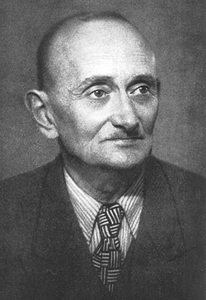
Professor A.A. Paramonov Research studies of plant parasitic nematids in particular, were started in the Centre of Parasitology of the A.N. Severtsov SIEE RAS (the former Gelminthological Laboratory of the AS USSR (GELAN), the Institute of Parasitology of the RAS) in April 1952, and were linked with the name of Professor A.A. Paramonov. For the past decades 3 noticeable and successively connected periods could be distinguished in the work of the Laboratory. Faunistic investigations of Nematodes of agricultural and wild plants in different soil-climatic areas of European and Asian parts of the former Soviet Union laid the foundation for a new field of research. Subsequently research studies were diversified to deal with phytonematode ecology, biology of multiplication and feeding, morphology, onthogenesis, interrelations with other components ob biocenoses (fungi, bacteria) and disease specificity in plant-hosts. Materials obtained by first GELAN phytonematologists and post-graduates in different regions of the country (E.S. Turlygina, C.A. Mjuge, P.S. Krylov, I.A. Baranovskaya, I.M. Sudakova, L.J. Damanskaya, T.V. Pokrovskaya, I.J. Eliava, J.A. Shlepetene, Z. Balbaeva, Z. Skuodite, G.I. Soloveva, A.S. Eroshenko et al.) served as a basis for Prof. A.A. Paramonov to develop the concept of phytohelminthology as an original scientific discipline with peculiar study objects, methodology, targets and trends. The first period culminated in a three-volume monograph written by A.A. Paramonov “Essentials of Phytonematology” (1962, 1964, 1970) that provided main concepts of the new science which are as follows: ecological classification of soil-dwelling nematodes, based on relations with plants; classification of phytohelminth life cycles considering different stages in connection with plants and soil as well; mycotrophic hypothesis of Tylenchida phytoparasitism origin rising from most ancient nematode-fung interrelations; notion of phytohelminths as biocenotic processes in which, apart from causative agents, saprobiotic nematodes, fungi and bacteria are involved; tenets on plant protective properties and therapy in phytohelminthoses and many others. It is noteworthy that they have not lost their scientific significance hitherto. The monograph was translated into English and considered basic one from ecological viewpoint. 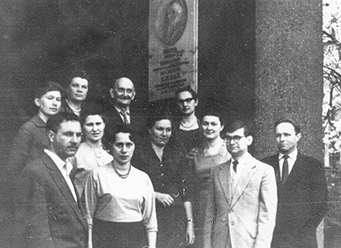
The fellows of the Sector of phytohelminthology, 1962 In 1962 an independent subdivision, the Cabinet of Phytohelminthology, was established and in 1965 it was renamed as the Sector of Phytohelminthology headed by A.A. Paramonov. After his death in 1970 it was A.A. Turlygina who took the position. During the 2-nd period investigations were performed in two directions: 1) studies of factors involved in formation of phytonematode natural faunistic complexes and agrocenoses; 2) studies of interactions between nematodes and plant-hosts. I.A. Baranovskaya, V.G. Gagarin, V.G. Gubina, L.V. Pavljuk, T.M. Pokrovskaya, N.I. Sumenkova, L.V. Shubina were among the leading specialists of the first direction. In terms of methodology those studies could be assessed as ‘experimental faunistica” since most of them were carried out under field conditions with the use of statistic analysis methods. The results of their studies found reflection in relative monographs devoted to Neotylenchoidea (three monographs in the serial “Nematodes of Plants and Soil” (Sumenkova, 1975), Aphelechoidea and Seinuridae (Baranovskaya, 1971), the genus Dytilenchus (coauthors, 1982) as well as monographs on nematodes of coniferous species (Gubina, 1980), meloidoginosis and control of gall nematodes (Pokrovksaya, 1988). Many of the monographs mentioned have been translated into English, published abroad and received broad recognition. During the 2-nd historic period the range of researches carried out by E.S. Turlygina, her post-graduate students S.V. Zinovieva and N.A. Kostyuk embraced experimental studies of nematode onthogenesis, multiplication biology and search for criteria of plant resistance to phytohelminths. The doctoral thesis defended by N.A. Kosryuk elucidated embryonal and post-embryonal development in broad range of phytonematode taxa; monographic report made by E.S. Turlygina, V.N. Chizhov, 1991 summarized the long-time researches on phytonematode morphology, multiplication biology and evolution of reproductive system; the works of S.V.Zinovieva laid the foundation of a new field of research – plant immunity to phytohelminths. The data obtained made it possible to develop a hypothesis of plant immunity formation to parasitic nematodes co-evolved with phytonematode parasitism. In the recent 15-20 years (the 3-rd period of development) traditional phytonematode taxonomic and ecological studies were raised to subspecies (populational) and subpopulational levels due to application of biochemical and molecular methods. Studies were promoted in forest nematology (O.A. Kulinich, Dr.Biol.Sci., V.N. Chizhov, Cand.Biol.Sci.). Faunistic researches of phytonematodes from different resource plants were recommenced (V.N. Chizhov, Cand.Biol.Sci.). Biocenotic studies have provided the basis for a new trend –phytoparasite cenology. Nowadays and independent Group of Phytoparasite Cenology is affiliated within the Laboratory (the head N.D. Romanenko, Dr.Biol.Sci.). Over the years 1989-1995 N.D. Romanenko, Dr.Biol.Sci., Paramonov’s disciple who was engaged from the Institute of Horticulture of Non-Chernozem Zone of RF, headed the Sector. In 1995 Corresponding Member of the RAS M.D. Sonin succeeded N.D. Romanenko and held the position until retirement in 2001 and later was replaced by S.V. Zinovieva, Dr.Biol. Sci. In the last decennium two new research trends have been developing: 1) elaboration of prognosticiation models for number dynamics, damage and economic losses due to phytoparasitic nematodes (K.A. Perevertin, Dr.Biol.Sci.) and 2) formation of computing database on phytonematodes being registered in the Laboratory collection. For maintenance and handy use of information available, there were created: 1) Atlas, a handbook on phytonematode taxonomy which includes data on 7,000 species of soil-dwelling and phytoparasitic nematodes belonging to 682 genera; 2) a collection of 40,000 reprints on phytohelminthology and 3) a collection of permanent preparations of 3,500 registered microscopic slides including over 10,000 specimens identified to specific (500 species of which 144 are types) or higher taxonomic levels (genus, family). It is being registered as a National collection with type species added to. The international scientific cooperation played a prominent role throughout the history of the Laboratory. Our research fellows had close relations with specialists from Germany, Hungary, visited Cuba, hosted post-graduates and probationers from Bulgaria, Czechoslovakia, Hungary, India, Vietnam, Cuba, Jordan, Sierra Leone and all republics of the former SU. In the recent years the international cooperation is being broadening due to involvement in grants with scientists from Great Britain, Belgium, Germany and China. The list of major publications of the Laboratory includes: 13 monograph volumes, 8 subject miscellanies, 3 scientific popular leaflets, 2 websites and more than 1,000 scientific papers in the Transactions of the Institute and other domestic or foreign editions, several patents and recommendations for practitioners. MAIN GOALS AND TASKS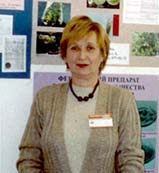
The head of Laboratory Laboratory of phytoparasitology works in three main directions:
Most important achievements1. For the first time on the basis of molecular-genetic studies of different parts of ribosomal RNA genes (28S, 18S and inner transcribing spacer) phylogenetic analysis of the nematodes of the order Tylenchida - the main order of phyto- and entomoparasitic nematodes was carried out. Phylogenetic interrelations between species and genera of the families of Criconematidae, Heterodehdae, Pratylenchidae, Hoplolaimidae, Anguinidae, and between populations and species of the genera of Ditylenchus, Aphelenchoides, Bursaphelenchus, Radopholus, Meloidoderita, Zeldia were reconstructed. The methods of express-diagnostics of phytoparasitic nematodes on the basis of PCR technology were developed (PCR with specific primers, real time PCR, and PCR with polymorphism of restriction fragments), including the following economically important species: Heterodera glycines, H. schachtii, Ditylenchus dipsaci, Globodera rostochiensis, G. pallida and Bursaphelenchus xilophilus. Co-evolutionary relations between parasitic nematodes and their host plants were analyzed. On the basis of morphological and molecular-biological studies 16 species and one genus of nematodes were described. More than 600 sequences of ribosomal and other genes of nematodes and bacteria associated with nematodes were given to the International Gene Bank. The database on secondary structure of ribosomal genes was created for phytonematodes. 2. A revision of pathogenic nematodes of suborder Hexatylina (Tylenchida) was carried out. On the basis of morphological criteria and peculiarities of life cycles, four new subfamilies were validated and the guide for families (subfamilies) and genera determination was suggested. 3. An analysis of distribution of dangerous parasites of coniferous woodlands - arboreal nematodes of the genus Bursaphelenchus (Aphelenchida) in 20 regions of Russia was completed. A revision of nematodes of this genus including 71 species was carried out. Quarantine species - pine arboreal nematode B. xylophilus, with which forest export is connected, has not been found on the territory of the RF. On the basis of the data on parasite biology (the presence of plants-hosts, beetles-carriers, the amount of necessary temperatures for development etc.) the regions of possible contamination of coniferous species with this parasite in the case of its invasion to the territory of the RF were determined. It was established that the death of coniferous species in the territory of the RF could be caused by B. mucronatus. A dendrogram of phenetic similarity of the species of the genus, including connections of the nematodes with host plants and carrier beetles, and also interactive electronic guide of nematodes of the genus Bursaphelenchus, including descriptions of the species, their host plants, carrier insects and the region of distribution were created (the work was carried out together with the Institute for Zoology of the RAS). 4. For the first time the interrelations of nematodes-mycophages with phytopathogenic and saprophyte fungi were studied. The differences in species composition and population density of nematodes were determined in saprophyte (industrially cultivated true mushroom) and phytopathogenic fungi (the species of the genera Verticillium and Fusarium). It was established that interrelations of mycophage nematodes and mycelium of fungi were developing according to the type of parasite-host connections. For the first time it was determined that number, age and sex composition, morphometric peculiarities, behavior in the process of feeding and continuation of its separate phases were the manifestation of different degree of mycophage specialization as parasites of mycelium. 5. Interconnections of parasitic nematodes, fungi, viruses in phytocenoses were studied. The patterns of distribution of nematodes of the families of Longidoridae and Trichodoridae - the carriers of nepo- and torba-groups of the viruses on the territory of the RF were revealed. The specific composition and special distribution of nepo- and torba- viruses and nematodes, their carriers in the fruit and berry, cereal, potato, decorative and fabaceous cultures were determined, the evaluation of their harmful action was given. The role of nematodes in development of viral epiphytoties was determined. Co-evolutionary interrelations of nematodes and parasitic bacteria of the genus Pasteuria were analyzed. Several species and genera of bacteria, associated with nematodes were described. 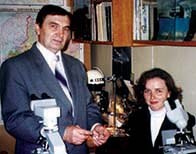
Dr. Biol. Sci., main res. ass. 6. The mechanisms of phytoparasitic nematode population formation in biocenose were revealed. Original studies made on populations of 15 species of parasitic nematodes - representatives of the orders Dorylaimida, Rhabditida, Aphelenchida, Tylenchida, showed that the basic factors, determining population parameters (density (relative number), age and sexual composition, dimensional characteristics of the individuals), were: species-specific features of parasites (biology of reproduction, fertility, continuance and peculiarities of ontogeny (the presence of obligate or facultative diapause) etc.); the peculiarities of parasite-host relations (obligatory or facultative parasitism, ecto- or endoparasitism, sedentary or errant species); the influence of soil-climatic and hydrometeorological conditions, host plants, their physiological state, phase of development, immune status. On the basis of the data about mechanisms of phytonematode population structure formation, biologically grounded methods and approaches for parasite population management in concrete systems parasite-host and phytocenoses were suggested, developed and approved; these methods and approaches included induction of plant resistance with biogenic elicitors and adaptogens, use of biopreparations created on the basis of bacteria and fungi, land treatment and technologies of culture growing etc. 7. New data about immunobiological mechanisms of coadaptation in the systems plants - parasitic nematodes were obtained. The regulatory role of isoprenoid metabolism in formation and dynamics of parasite-host relation in the systems plants - parasitic nematodes was determined. The role of elicitors and signal molecules in initiation of immune reactions in plants in response to nematode invasion was studied. The mechanism of induction of plant resistance to sedentary nematodes with the help of biogenic elicitors (chitosans, polyunsaturated fatty acids - arachidonic, eicosapentaenoic), and also the mechanism of suppression of nonspecific immune responses were revealed. It was shown that in the process of resistance formation in the plants to phytonematodes, the signal molecules - methyl ether of jasmonic acid and salicylic acid - and enzymes of antioxidant complex took part actively. The lowering of activity of the latter as a result of inhibition by salicylic acid led to oxidative burst and expression of protection genes. The state of nematode population in immunized plants was analyzed. The role of phytoimmunity in modification variability of nematodes was revealed. 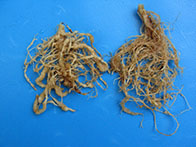
The roots of tomatoes, invaded by gallic nematode (left - control, right - chitosan treatment). 8. A mechanism of influence of furostanolic glycosides (FG) - natural plant adaptogenes, isolated from the cell culture of Dioscorea deltoidea - on immune potential of plants, invaded with phytohelminthes was revealed. It was established that FG action was connected with the influence on intercellular membranes, which included sterols (in cytoplasm) or isoprenoid pigments (in plastids). The character of changes in composition of chloroplast pigments of plants under nematode invasion showed that FG maintained plant cell homeostasis, thereby stimulating phytoimmunity. Preparation of FG was approved in industrial conditions as an instrument for plant protection against nematodes. (This work was fulfilled together with the A.N. Bakh Institute of Biochemistry of the RAS). 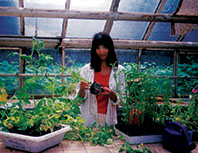
Ph.D. Biol. Sci., senior res. ass. 9. A system of prognostic models of the number and harmfulness dynamics for the most pathogenic nematode species - potato, cyst-forming, beet bin, gallic and stem ones - was developed. The models on number dynamics determine functional relation of the helminthes population density at the end of vegetation period with the pre-sowing density. For the plants-hosts this dependence has a polynomial form with positioning above the line of equilibrium density, for non-injuring cultures the dependence is linear with positioning below the line of equilibrium density. Imitation block allows the modeling of the versions of argobiocenose contamination development at any set of culture and for any number of years. The models of harmfulness bind harvest yield and pre-sowing density of nematodes. Determination of the parameters for concrete agrobiocenoses was carried out in conditions of Non-chernozem region (Vladimirskoe Opol'e) and was started for chernozem territories (Voronezh Region). These works were reflected in methodical recommendations and in a special monographic report. |